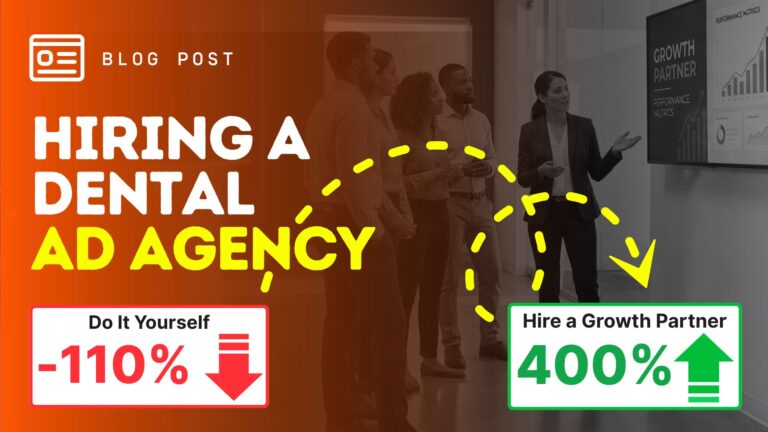We’ve all experienced the frustration of a slow-loading website. More often than not we click back to the search engine and abandon that search result and try another. If you are the owner of a small business such as an orthodontics practice, this can have a significant impact on your growth. Loss of new patient inquiry will have a definite impact on your bottom line.
Your website, both the mobile version and desktop, needs to load quickly and allow easy navigation without further delays. So if your website is experiencing delays or freezing, what can you do to improve the situation? Let’s find out.
What Is Site Or Page Speed?
Site speed in simple terms is how long it takes for your browser to receive information from the server and load a webpage.
According to Google, the recommended or ideal page load time is under two seconds:
“Two seconds is the threshold for eCommerce website acceptability. At Google, we aim for under a half-second.”
What Causes A Slow Website?
A slow website can be caused by several factors. The content contained on each of your site’s pages contributes to the speed with which it loads. Things such as images, videos, javascript files, HTML code, CSS that styles page elements, other multimedia such as music and more all take time to load and impact the loading speed. Web pages load piece by piece rather than all at once, so the more that a site contains, the slower the potential load time.
Each of these elements is measured in kilobytes and their total kilobytes combined with the server speed will all influence the speed with which your website loads. The user’s internet speed and choice of browser will also influence this, but this of course is outside of your control.
Page Speed vs Website Speed
Page speed and website speed are similar, however page speed is focused on optimizing specific page attributes to decrease their load times. Website speed is more focused on how quickly a guest to your page can navigate through from the first click to the lead form.
Great website speed delivers a seamless experience for the user and helps to funnel them through to the desired outcome, such as booking their orthodontics appointment with your practice.
Why Is A Fast Site Important?
A fast site is important, potential patients want easy, quick service – it’s a staple of great customer service. Research shows us that when a page is slow to load, the likelihood of a user ‘bouncing’ off your page and looking for alternatives increases rapidly with each second of delay. Ultimately, speed = revenue.
Image courtesy of MachMetrics
Why does this happen? Ultimately, human beings are impatient. We are used to getting things faster than ever, particularly online via a search engine. When a page fails to load quickly, the overall perception of your orthodontics practice as a professional entity is impaired. Many users may even assume your site is broken and give up on seeking your services entirely. In fact, 79% of customers say they would not revisit a site that delivered poor speed performance.
Search Engine Optimisation
From a search engine optimization (SEO) perspective, a slow website impairs the user experience. If you only ever understand one component of SEO, it’s that Google prioritizes the user experience above all else. If your site consistently underperforms and loads slowly, Google is going to penalize you and lower your ranking.
The higher chance of users bouncing off your page and spending less time within your site will also contribute indirectly to your ranking. This is why ensuring your page loads and operates at peak speed is critical. With reduced visibility, your orthodontics practice is going to miss out on essential new patient inquiries.
Ways To Improve Your Website Speed
So what are your options if your page loads slowly? For starters, you may need to eliminate some of the elements on the page. While this may seem counterintuitive to remove what you deem as critical content, less is more, and faster is better overall. This is particularly important for mobile users where both the speed and size of your site matter. With around 53% of web traffic coming from mobile devices, it is a corner of the market you cannot afford to ignore.
Other measures for improving speed and increasing conversion include:
- Compressing images and reducing their size.
- Reducing, combining, or ‘minifying’ your HTML, CSS, and JavaScript files. Minifying involves removing unnecessary formatting, whitespace, and code.
- Choosing asynchronously over synchronously. This means setting up some aspects of your page to load at the same time rather than one by one.
- Consider switching to a faster DNS provider to ensure you are being offered the fastest server speeds.
- Upgrading your hosting to include a dedicated server over a cheaper shared option.
- Enable browser caching so essential elements of your page can be stored in the user’s browser to speed up future visits.
These are just a few examples of the steps you can take to improve the speed and overall user experience of your website.
Need Help?
We get it, your specialty is orthodontics, and getting a handle on all the tech associated with running a great website may not be something you time for. At HIP Creative, we not only understand how to create a great website, but we’re also passionate about it.
We are committed to helping you build a bigger practice and a powerful brand. We’re the orthodontic growth partner that turns your prospects into profit with your website forming a key component of this success. We’re far from just your average marketing firm – we aim to be an active partner in your business too. We are dedicated to constantly optimizing, training your staff, and bringing you fresh ideas from our nationwide network of orthodontic practices.
We guarantee that once you experience the growth and excellent service that we deliver, you’ll never look back. Contact our skilled and friendly team today on 833.975.2592 or email us and we’ll get back to you as soon as possible.






